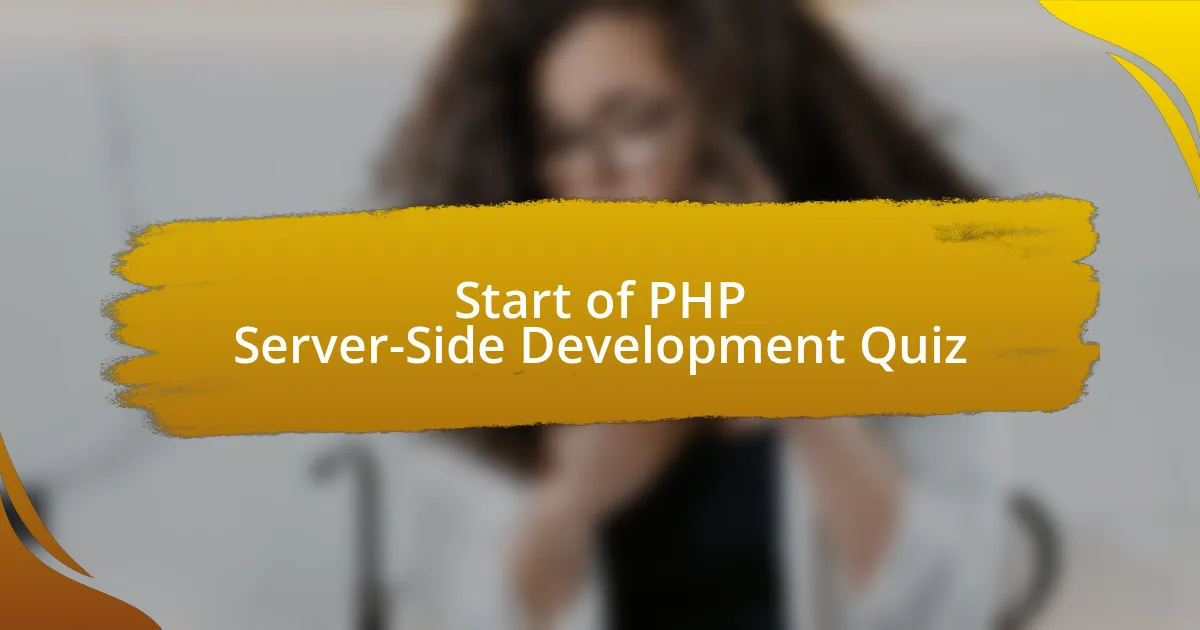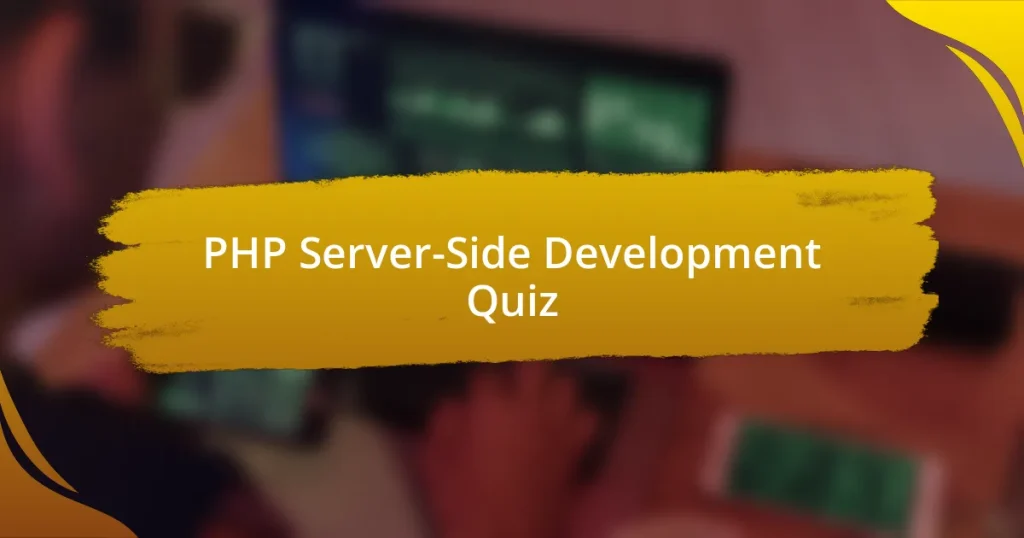
Start of PHP Server-Side Development Quiz
1. What is the primary function of PHP in server-side development?
- PHP processes user requests on the server and sends the results back to the browser as HTML.
- PHP converts HTML documents into XML format for browsers.
- PHP handles client-side scripting tasks and events.
- PHP creates static web pages and stores them on the server.
2. Which web servers are able to run PHP scripts?
- Nginx
- Google Chrome
- Apache
- Firefox
3. How many functions does PHP include for Perl-compatible regular expressions?
- 12 functions
- 6 functions
- 10 functions
- 8 functions
4. What is the default session name used in PHP?
- PHPSESSID
- PHPSESSION
- DEFAULT_SESSION
- SESSION_NAME
5. How can you start a session in PHP?
- session_start()
- initiate_session()
- start_session()
- begin_session()
6. What distinguishes require() from include() in PHP?
- include() always returns a boolean
- require() stops execution on error
- include() aborts the script on failure
- require() does not include files
7. In PHP, how do you define a constant?
- create_constant(`CONSTANT_NAME`, value);
- define(`CONSTANT_NAME`, value);
- constant_define(`CONSTANT_NAME`, value);
- set_constant(`CONSTANT_NAME`, value);
8. What types of arrays can be created in PHP?
- String arrays, object arrays, and class arrays.
- Dynamic arrays, static arrays, and linked arrays.
- Indexed arrays, associative arrays, and multidimensional arrays.
- Multiscope arrays, constant arrays, and tuple arrays.
9. What is the difference between arrays and lists in PHP?
- An array is limited to 10 elements, while a list can hold more.
- An array is a data structure that holds ordered elements, while a list is just a numeric array.
- An array stores mixed data types, but a list only holds integers.
- An array always holds unique values, while a list can have duplicates.
10. How do unset() and unlink() differ in PHP?
- `unset()` defines a function, while `unlink()` initiates a session.
- `unset()` stops a script, while `unlink()` checks permissions.
- `unset()` clears the cache, while `unlink()` uploads a file.
- `unset()` removes a variable, while `unlink()` deletes a file.
11. What function is used to create a cookie in PHP?
- makecookie()
- newcookie()
- setcookie()
- createcookie()
12. How does a generator function work in PHP?
- A generator allows for efficient iteration over values using `yield`.
- A generator only returns a single value when called.
- A generator creates a new variable for each function call.
- A generator stores all values in an array for iteration.
13. What is the correct syntax for a foreach loop in PHP?
- foreach ($array as $value) { // code }
- foreach ($value as $array) { // code }
- for each ($array as $value) { // code }
- foreach ($array; $value) { // code }
14. What are the core variable types in PHP?
- Strings, objects, arrays, functions
- Booleans, dictionaries, variables, classes
- Characters, lists, maps, integers
- Integers, floats, strings, booleans
15. How do classes and objects differ in PHP?
- A class is a subroutine, while an object is an executable statement.
- A class defines variables, while an object defines functions.
- A class is a blueprint for objects, while an object is an instance of a class.
- A class is a type of variable, while an object is a function.
16. What is the syntax to declare an array in PHP?
- array(value1, value2);
- array = new Array();
- $array = array();
- $array[] = value;
17. What is the role of PDO in PHP development?
- PDO is used for file uploads in PHP applications.
- PDO provides a data access abstraction layer for different databases.
- PDO operates as a caching mechanism for PHP scripts.
- PDO is a template engine for rendering HTML in PHP.
18. How can you connect to a database using PHP?
- You connect to a database using database_link() method.
- You connect to a database using db_connect() only.
- You connect to a database using connect_db() function.
- You connect to a database using mysqli_connect() or PDO::connect().
19. What does the session_destroy() function accomplish in PHP?
- The `session_destroy()` function destroys all data registered to a session.
- The `session_destroy()` function saves session data to the database.
- The `session_destroy()` function creates a new session.
- The `session_destroy()` function initializes a session.
20. What methods can be used for validating form data in PHP?
- You validate form data in PHP by checking for empty fields.
- You validate form data in PHP by doubling the input values.
- You validate form data in PHP by ignoring empty fields.
- You validate form data in PHP by storing it as-is.
21. How do echo and print differ in PHP’s output?
- `echo` is used for debugging, while `print` is for user input.
- `echo` does not return a value, while `print` returns 1.
- `echo` can handle arrays, while `print` cannot.
- `echo` only outputs strings, while `print` outputs numbers.
22. What is the purpose of the preg_match() function in PHP?
- The `preg_match()` function searches for a pattern in a string and returns the number of matches.
- The `preg_match()` function creates a new string based on a pattern.
- The `preg_match()` function formats a string into a specific pattern.
- The `preg_match()` function deletes a pattern from a string.
23. How are regular expressions utilized in PHP?
- You cannot use regular expressions within PHP at all.
- You require a special library to handle regex in PHP.
- You use array functions to manipulate regex patterns.
- You use functions like `preg_match()` and `preg_replace()` for regex.
24. What does the array_key_exists() function do in PHP?
- The `array_key_exists()` function sorts the keys of an array.
- The `array_key_exists()` function checks whether a key exists in an array.
- The `array_key_exists()` function merges two arrays together.
- The `array_key_exists()` function removes a key from an array.
25. How can an array be sorted in PHP?
- You can sort an array using `sort()`.
- Invoke the `array_count()` function.
- Use the `array_keys()` function.
- Sort with `array_merge()`.
26. What is the purpose of the unset() function?
- The `unset()` function starts a new PHP session.
- The `unset()` function removes a variable from the scope.
- The `unset()` function deletes a file from the system.
- The `unset()` function initializes an array.
27. What techniques are available for error handling in PHP?
- You handle errors in PHP using functions like `error_reporting()` and `set_error_handler()`.
- You handle errors in PHP using the `http_response_code()` function.
- You handle errors in PHP with `array_push()` and `in_array()`.
- You handle errors in PHP by using HTML and CSS for styling.
28. How does session_start() function in PHP work?
- It starts a new session or resumes an existing one.
- It deletes session data and stops the script.
- It initializes PHP variables used for sessions.
- It encrypts the session data for security.
29. What is the method for creating a multidimensional array in PHP?
- You create a multidimensional array by using the json_encode() function.
- You create a multidimensional array with single-dimensional arrays.
- You create a multidimensional array by nesting arrays within each other.
- You create a multidimensional array using the array_fill() function.
30. What does array_push() do in PHP?
- The `array_push()` function sorts the elements in an array.
- The `array_push()` function adds elements to an array`s end.
- The `array_push()` function checks for duplicates in an array.
- The `array_push()` function removes elements from an array.

Quiz Completed Successfully!
Congratulations on completing the quiz on PHP Server-Side Development! This interactive experience has not only tested your knowledge but also deepened your understanding of server-side programming. From fundamental concepts to practical applications, you’ve explored key aspects that can enhance your skills as a developer.
Throughout the quiz, you likely discovered new insights regarding PHP syntax, functionality, and best practices. Understanding the importance of server-side scripting can empower you to create dynamic and interactive web applications. Engaging with these concepts solidifies your foundation and prepares you for more advanced topics in web development.
To continue your journey, we invite you to explore the next section on this page dedicated to PHP Server-Side Development. Here, you’ll find informative resources that will expand your knowledge even further. Dive into tutorials, examples, and deeper explanations that will enhance your skills and confidence in using PHP effectively.

PHP Server-Side Development
Understanding PHP as a Server-Side Language
PHP is a widely-used, open-source scripting language designed specifically for web development. It allows developers to create dynamic content that interacts with databases. Unlike client-side languages, PHP runs on the server, generating HTML that is sent to the client’s browser. Its versatility and strong community support make it ideal for various web applications, from simple websites to complex web platforms.
The Role of PHP in Web Development
In web development, PHP serves as a bridge between the front-end and back-end processes. It enables server-side logic, facilitating data storage and retrieval through database interaction. PHP is commonly used with MySQL databases, allowing for efficient data management. This integration supports various functionalities like user authentication, content management, and data reporting.
Key Features of PHP for Server-Side Development
PHP offers numerous features that enhance server-side development. These include ease of integration with HTML and other technologies, extensive library support, and built-in sessions for user management. PHP’s object-oriented programming (OOP) capabilities allow for more structured and maintainable code. Additionally, it supports various protocols, enabling functionality like file uploads, and sending emails directly from the server.
Popular PHP Frameworks for Development
Several PHP frameworks streamline the development process, promoting best practices and efficiency. Laravel is known for its elegant syntax and robust features, while Symfony offers a comprehensive set of reusable components. CodeIgniter is lightweight and easy to learn, making it suitable for small projects. These frameworks help developers build secure, scalable, and maintainable applications more quickly than coding from scratch.
Implementing Security in PHP Applications
Security is paramount in PHP server-side development. Developers must implement measures to protect against common vulnerabilities, such as SQL injection and cross-site scripting (XSS). Techniques include utilizing prepared statements for database queries and validating user input. Using SSL encryption enhances data security during transmission. Regular updates to PHP and its frameworks help mitigate security risks, ensuring application integrity.
What is PHP Server-Side Development?
PHP Server-Side Development is a programming approach where PHP (Hypertext Preprocessor) is used to create dynamic web applications. It processes customer requests on the server before sending the output to the client’s browser. PHP can connect to databases, manage sessions, and handle form submissions, which are critical for interactive and data-driven applications. According to W3Techs, as of October 2023, PHP is used by 79% of all websites with a server-side programming language.
How does PHP Server-Side Development work?
PHP Server-Side Development works by executing PHP scripts on the server upon receiving a request. The server processes these scripts, interacting with databases as needed, and generates HTML content. This content is sent to the client’s browser for display. PHP can run on various platforms, with the most common environments being Apache or Nginx servers. The PHP engine interprets the code, allowing developers to create functionalities dynamically.
Where is PHP Server-Side Development commonly used?
PHP Server-Side Development is commonly used in website development, content management systems (CMS), and e-commerce platforms. Popular CMS like WordPress, Joomla, and Drupal are built using PHP. It enables the creation of user interactions, database management, and real-time data processing, making it ideal for applications requiring user engagement and database connectivity.
When was PHP Server-Side Development first introduced?
PHP Server-Side Development was first introduced in 1995 with the release of PHP/FI (Personal Home Page / Forms Interpreter) by Rasmus Lerdorf. It began as a set of tools for building personal web pages, evolving significantly to accommodate a wide range of web development needs. PHP 3, released in 1998, marked a pivotal moment by expanding its capabilities, making it popular among web developers.
Who uses PHP Server-Side Development?
PHP Server-Side Development is used by web developers, startups, and large enterprises alike. It attracts a wide range of users due to its ease of use and strong community support. According to Stack Overflow’s Developer Survey 2023, PHP is one of the top programming languages employed by developers globally, particularly for building web applications and services.
















